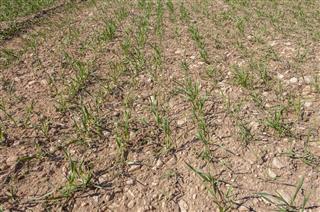
Barley grass is the leaf part of the barley plant. The grass is rich in vitamins, minerals, and is also a potent antioxidant. The following article provides information about the various benefits of this grass.
Barley grass is the common name given to the cereal grasses that belong to Hordeum species from the Poaceae family. Barley is used in the preparation of a number of foods, and is also used in the preparation of beer. It is an annual plant that grows up to a height of 3 feet. It has a hollow stem and produces amber-colored, elliptical, and furrowed seeds. It is harvested when the plant is young, that is, before its development. The grass is known to contain many nutrients, and is used as an alternative treatment for several diseases.
Benefits
While the grains are used in a variety of recipes in many parts of the world, the grass (shoot or the stalk of the plant) contains several essential nutrients and has gained popularity as a health food supplement. The amount of proteins and fibers present in just 5 g of this grass is almost similar to that in one serving of 114 g of raw spinach. It contains vitamins, minerals, proteins, and amino acids that are essential components of the human diet, and is considered to be one of the most nutritious grasses. It is commercially available in the form of juice or powder, that can be added to foods. It is also available in the form of tablets or capsules.
- Barley is a rich source of vitamin A, vitamin B1, vitamin B2, vitamin B12, vitamin C, vitamin E, and folic acid, which are required for the normal growth and development of our body.
- It contains several natural antioxidants and phytochemicals that help in neutralizing the free radicals, thereby preventing free radical damage.
- It is naturally rich in minerals like iron, calcium, copper, manganese, potassium, and zinc which may prove beneficial for various conditions including hypertension, heart diseases, diabetes, arthritis, asthma, anemia, and kidney problems.
- It contains a plant chemical known as proanthocyanidin, which is extremely effective against free radicals and other harmful toxins. It strengthens the immune system, and helps in reducing the risk of infection and inflammation.
- The grass contains high levels of chlorophyll, which is found to be beneficial for the stimulation of tissue growth. It also stimulates the growth of red blood cells, which promote oxygen supply. Chlorophyll, along with some other essential nutrients, remove carbon monoxide and carbon dioxide from the body and help in reducing urinary, fecal, and body odor. It also detoxifies the body.
- Powder of this grass improves the production of hydrochloric acid in the stomach, which is needed in the process of digestion. It is also rich in organic sodium which improves digestion and is used as a remedy for constipation.
- The antioxidants present in this plant are believed to protect the skin from aging and a number of skin problems such as acne and ulcers. They may also prove beneficial in the inhibition of cancerous cells.
- The grass is a rich source of amino acids, both essential and non-essential ones. Amino acids are the building blocks of the body and help in the development of muscle tissues.
Because of its high nutritional value, organic barley grass is often used as a substitute for wheat and oatmeal.

